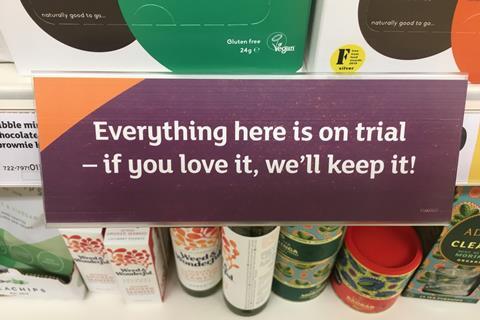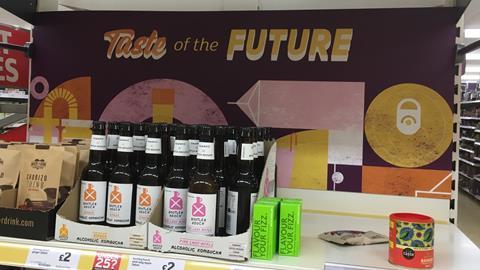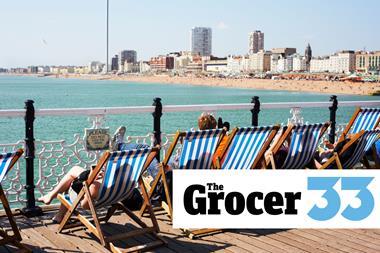It’s the scheme that promises to introduce shoppers to new food trends while giving up-and-coming brands the chance of a full supermarket listing if they prove a hit.
Launched last week, Taste of the Future is the latest phase of Sainsbury’s Future Brands programme, designed to identify ‘distinctive’ disruptor brands and help the supermarket stand out from its big four rivals as ‘Destination Sainsbury’s’. So how does the initiative work? And what challenges will successful brands face on the way to a listing?
Where are the bays?
Taste of the Future incubator bays have been launched into 69 superstores, featuring 30 SKUs from 11 small challenger brands. Information on the bays explains ‘Everything here is on trial - if you love it, we’ll keep it!’
The bays will be updated every 14 weeks with a new raft of products each time.
Brands are offered guidance, mentoring and benefits such as free data, before being listed in Sainsbury’s Local stores and supermarkets, often in exchange for exclusivity.
What brands are involved?
The brands to feature in the first wave are:
- Sea Chips - crisps made using the often-wasted skin of salmon
- Doctor Seaweed’s Weed & Wonderful - seaweed wild harvested in the Scottish Outer Hebrides and incorporated into infused oils
- Bootleg Booch - crafted alcoholic kombucha
- Aduna - an Africa-inspired food brand whose range includes teas and powders
- Boundless - a snack range which blends seeds and nuts
- Feed - a French food company that develops balanced meals for vegan, gluten-free and lactose-free diets
- Made for Drink - premium bar snacks such as Chorizo Thins and Mangalitza Salami Chips
- Nibble Brownie Bites - lower-sugar vegan brownies
- Prime Bar - a protein bar made using grass-fed British beef blended with fruits, herbs and spices and slow-cooked over five hours
- Smith & Sinclair - a range of alcoholic cocktail gummies and drink flavours
- Tea Rex - a fruit infusion made of fresh, finely chopped fruits and roots.
What’s the thinking?
There is a line of thought that this initiative is all about attracting those much-lauded millennial shoppers, but Sainsbury’s head of Future Brands Rachel Eyre says it is actually about “keeping existing customers surprised and delighted as well as attracting as many new customers as possible”. Consumer research into who is buying products already championed in the wider Future Brand programme shows they are Sainsbury’s customers of all ages, she says.
The featured products are generally premium, with price tags to match, and considered likely to be more popular in London and the south east, where most of the 69 trial stores are located.
“At Sainsbury’s we want to offer our customers the most innovative and interesting products around,” explains Eyre.
“We’re dedicated to helping our customers test and trial new innovations in the grocery space, and can’t wait to hear what they think of these options.”
Eyre hails the wider Future Brands project, which launched a year ago, as a major success, with 150 brands now included in the portfolio. Some of the more high-profile names among these include Beavertown brewery and Wasabi.
“We want to build suppliers’ perception that we are best in class for challenger brands and we want customers to see Sainsbury’s as the retailer that is supporting these brands.”
Sainsbury’s is not the only retailer championing challenger brands with such a scheme. Tesco has just named the nine suppliers who will make up its incubator programme for 2019, adding to the 28 included since launch in 2017. Leading alumni from the scheme include BrewDog, Fever-Tree, Propercorn and Graze.

What’s the criteria for gaining a wider listing?
Participating brands have not been given a hard sales target in order to secure a listing. Rather, success will be judged across a number of factors, explains Eyre. This will include sales but also feedback from consumer panels, how popular they are with existing Sainsbury’s customers and their ability to attract new shoppers.
Should a brand prove its worth over the 14-week period, the Future Brands team will work with it as it transitions into working with the more mainstream buying department at the retailer.
What challenges do brands face in the trial?
To a degree, how these brands overcome the challenges involved might say more about their resilience in the long term than simple sales performance during the trial. There are issues around the supply chain and meeting Sainsbury’s order requirements on single pallets, and of course ensuring that individual stores are keeping the bays well stocked.
“Even at a 69-store trial level, monitoring compliance for a small brand like ours is too costly,” says Aduna founder and CEO Andrew Hunt.
This is where they are receiving help from Young Foodies, which can undertake much of this work on behalf of all 11 brands.
Another potential challenge for brands is driving awareness that the products are in Sainsbury’s. Although 69 stores is significant, as it isn’t a wholly national listing brands are limited in the support they can receive in the trial, such as advertising in the Sainsbury’s magazine. For Aduna, Hunt says it comes down to mobilising its growing fan base through “targeting sampling, online promotions and geo-targeted social media to rally our own community of loyal followers”. While he admits there isn’t as yet a huge following, he points to the 700-plus investors that backed the brand in its Seedrs fundraising campaign.
What do the brands think?
Unsurprisingly, brand owners are delighted to be given the opportunity. But beyond that, Hunt believes the scheme represents a fundamental shift in buying processes at the major supermarkets. The Future team is engaging with fledgling brands more supportively than they could expect of dedicated buyers, he says.
“Trying to gain listings can be a painful process, particularly for new products like ours. Often buyers don’t really understand the product and where it would fit in a category,” he explains.
“But with this, the Future Brands team are not coming at you as an aggressive buyer, they are actually listening and taking in what we have to say.
“I really hope that this scheme proves a success, not just for the brands involved but commercially for Sainsbury’s, because it is doing something different and it deserves to reap the benefits of that.”

Follow Ronan on Twitter: @ronyhegs View full Profile
























No comments yet